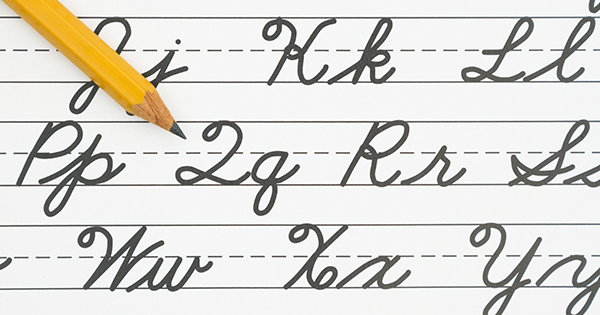
In the 21st century, teaching cursive writing is increasingly becoming more of the exception than the rule.
With computers emerging as the primary source for writing, many administrators feel teaching cursive writing is not necessary and believe the time would be better spent teaching keyboard skills. Many students and parents, however, believe that teaching cursive writing is still very relevant and should not be so quickly dismissed. Sound like a familiar debate at your school? Read on.
Cursive writing may be making a comeback, at least in some states. As of 2016, 14 states required cursive instruction. And in the fall of 2016, the nation’s largest public school district, New York City schools, began encouraging cursive writing instruction in the curriculum.
Maggie Wells from Parenting Squad polled teachers to uncover reasons cursive should be taught in school, and here’s what they said it does:
Develops motor skills
Cursive writing requires a very different skill set from print writing. It involves using the hand muscles in a different way. Additionally, it activates a different part of the brain than regular writing does. At the age cursive is taught, around 7 or 8 years old, these skills can be very beneficial in furthering motor skill development.
Reinforces learning
When students are taught the English language in only one form, print writing, they get only one chance to learn and memorize the letters. By having to learn cursive as well, students get another opportunity to fully comprehend the alphabet. Learning cursive also gives students a clearer understanding of how letters are formed, which will improve their print writing as well.
Working with legal documents
Being comfortable with cursive writing will guarantee students will be confident when writing and signing legal documentation. A cursive signature is most commonly required to endorse legal documents, accompanied by a printed version of their name too.
Writing and signing checks is another reason for learning cursive. Cursive writing has historically been the standard style when writing authorized checks for payment. Students risk being confident and successful when working with basic legal documents if they don’t learn cursive.
Helps students with disabilities
Students with learning disabilities, specifically dyslexia, can have a very hard time with writing in print because many of the letters look similar, particularly b and d. Cursive letters, however, look very different from print letters. This gives dyslexic students another option — an option that can decrease their dyslexic tendencies and make them more confident in their abilities.
Cursive is a lost art form
More and more school districts are cutting art from their budgets. This can be detrimental to the full development of students. However, cursive writing could be considered an art form all its own. It is one more way for students to develop the side of their brain that is not developed by basic reading and writing skills. The more diverse a teaching curriculum is, the better.
Connects students to the past
Without being able to read cursive writing, students will undoubtedly be kept from many opportunities to read important documents. Think about it: so many historical documents are written in cursive. While some of these documents are readily available online in print form, not all of them are.
Not only will students miss out on a part of history, they may very well miss out on reading important letters and cards from their grandparents or great-grandparents, too. Older generations often still write in cursive on a daily basis, and kids often rely on their parents to translate these letters and cards for them because they simply cannot read the cursive writing. Forty years from now, when these grandparents have passed on, kids may want to look back on these letters, and they should be able to read them properly.
So, should cursive be taught in school?
We believe, yes! Simply put, if teaching cursive writing is eliminated from schools, children could miss out on a lot. Though the world is becoming more and more technology dependent, there is something to be said for retaining a part of classic writing skills in the curriculum. Cursive reinforces the mantra that learning should simply be for learning — not just to pass a test.
Categorized as: Tips for Teachers and Classroom Resources
Tagged as: Engaging Activities, Language Arts, Leadership and Administration
